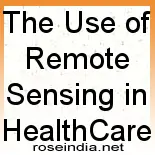Health is one of the few proactive sectors where the force of technology and its proactive presence is most felt and keeping tune with this obvious effect of technology the use of remote sensing in healthcare is fairly wide and numerous. Remote sensing works in numerous ways to improve the surveillance in healthcare and who will deny that if you can put remote surveillance of patient's movement and health attributes into action then it can naturally translate in better medical action on part of caregivers, physicians or technicians. Presently the demand of healthcare is increasingly becoming a factor that is directly propagating the industry to become more technology driven and well equipped with latest devices and the use of remote sensing in healthcare is just one of the stepping stones in that already flourished trend. Let us see first how remote sensing works and then subsequently how it is used in healthcare sector for the betterment of service and standard of healthcare.
How remote sensing works?
In its authentic definition remote sensing is the process of gathering information about an object without any physical contact or by being situated in remote location from the object of interest. Now the remoteness or the distance may vary from one context of use to another. Before we actually see the multitude of use of remote sensing in healthcare we must have an understanding of the basic functional properties of remote sensing and how it is employed in different contexts. According to the deployment of the technology to gather information from an object remote sensing is classified grossly into two types, respectively as passive remote sensing and active remote sensing. While in passive remote sensing the sensors on itself does not emit any radiation or signals to detect the objective information and only works through detection of the natural radiation from the object, in active remote sensing the procedure is just the opposite. In active remote sensing the equipment emits radioactive signals that detect the object and gathers information. While infrared devices or even photography itself can be taken as examples of passive remote sensing, RADAR is the most common example of active remote sensing.
Uses in healthcare
The use of remote sensing in healthcare is truly multifarious. In a sector which is constantly plagued by whopping healthcare demand and shortage of qualified professionals and support staffs truly any technology that provides better surveillance is a blessing. The following areas of uses will provide an idea that how the technology can revolutionize healthcare standard by many respects.
- Remote sensing for surveillance of patient's movements is the most important area that great many old age homes, psychiatric treatment centers can really find useful. For aged to mentally challenged people or critically ill persons, monitoring their movements even while they are in their home can be monitored and information can be sent to the caregivers in real time.
- For vector born diseases like malaria, anthrax, dengue and lots of other viral diseases that every year kills millions of people are for some years have become subject to wider research using remote sensing. The use of remote sensing in healthcare opened the pathways for these public health research initiatives that are increasingly becoming useful in analyzing the factors responsible for vector born diseases and potentially threatening environment in different affected or vulnerable areas.
- For ambulance and all types on the go healthcare facilities remote sensing can make the health information accessible for specialists and practitioners in real time and many a times attending support staffs can actually be guided on their tasks in real time.
- With remote sensing in place healthcare can function with better integration between various facilities through real time information sharing and access to live transmission of patient's condition. Naturally better integration is sure to translate into betterment of the sector as a whole.
